
Hoover Dam is a concrete arch-gravity dam in the Black Canyon of the Colorado River, on the border between the U.S. states of Nevada and Arizona. It was constructed between 1931 and 1936 during the Great Depression and was dedicated on September 30, 1935, by President Franklin D. Roosevelt. Its construction was the result of a massive effort involving thousands of workers, and cost over 100 lives. It was referred to as the Hoover Dam after President Herbert Hoover in bills passed by Congress during its construction; it was named the Boulder Dam by the Roosevelt administration. The Hoover Dam name was restored by Congress in 1947.
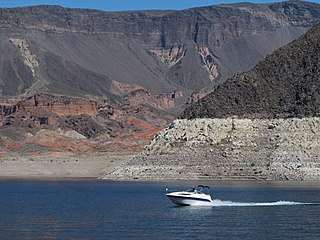
Lake Mead National Recreation Area is a U.S. national recreation area in southeastern Nevada and northwestern Arizona. Operated by the National Park Service, Lake Mead NRA follows the Colorado River corridor from the westernmost boundary of Grand Canyon National Park to just north of the cities of Laughlin, Nevada and Bullhead City, Arizona. It includes all of the eponymous Lake Mead as well as the smaller Lake Mohave – reservoirs on the river created by Hoover Dam and Davis Dam, respectively – and the surrounding desert terrain and wilderness.

St. Thomas, Nevada is a ghost town in Clark County, Nevada, near where the Muddy River flows into the Colorado River. St. Thomas was purchased by the US Federal Government and abandoned as the waters of Lake Mead submerged the town in the 1930s.
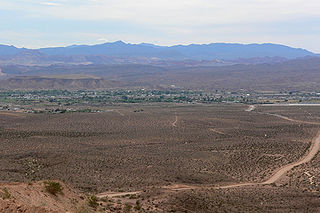
Overton is a community that is part of the unincorporated town of Moapa Valley in Clark County, Nevada. Overton is on the north end of Lake Mead. It is home to Perkins Field airport and Echo Bay Airport.

The Hohokam Pima National Monument is an ancient Hohokam village within the Gila River Indian Community, near present-day Sacaton, Arizona. The monument features the archaeological site Snaketown 30 miles (48 km) southeast of Phoenix, Arizona, designated a National Historic Landmark in 1964. The area was further protected by declaring it a national monument in 1972, and was listed on the National Register of Historic Places in 1974.

El Cuartelejo, or El Quartelejo, is a region in eastern Colorado and western Kansas where Plains Apache cohabited with Puebloans. Subject to religious persecution, Puebloans fled the Spanish Nuevo México territory and cohabitated with the Cuartelejo villagers in the 1600s.

The Nevada State Railroad Museum Boulder City is a railroad museum in Boulder City, Nevada which is an agency of the Nevada Department of Tourism and Cultural Affairs. The railway is located on the Boulder City Branch Line, the historic railroad route installed to support construction activities at the Hoover Dam. The state obtained the tracks and right of way from the Union Pacific Railroad in 1985.

State Route 169 is a state highway in Clark County, Nevada, United States. It connects the northern reaches of Lake Mead National Recreation Area to Interstate 15 (I-15) via Moapa Valley and the communities of Overton and Logandale. It is also called Northshore Road, Moapa Valley Boulevard, and Logandale Road.
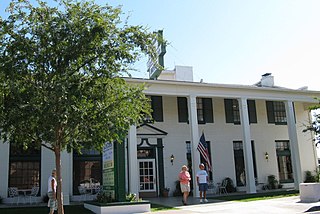
The Boulder Dam Hotel, also known as the Boulder City Inn, is a hotel located in Boulder City, Nevada that is listed on the United States National Register of Historic Places. It was designed in the Colonial Revival style by architect Henry Smith. The hotel was built to accommodate official visitors and tourists during the building of Boulder Dam, now Hoover Dam.
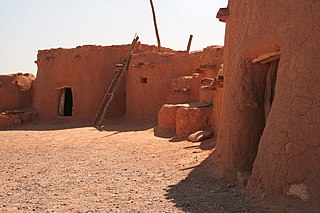
The Lost City Museum, formerly known as the Boulder Dam Park Museum, is located in Overton, Nevada and is one of seven managed by the Nevada Division of Museums and History, an agency of the Nevada Department of Tourism and Cultural Affairs.

Homestake Mine is located in the Newberry Mountains near Searchlight, Nevada. It is listed on the United States National Register of Historic Places for activities between 1850 and 1924. Gold and silver were mined.
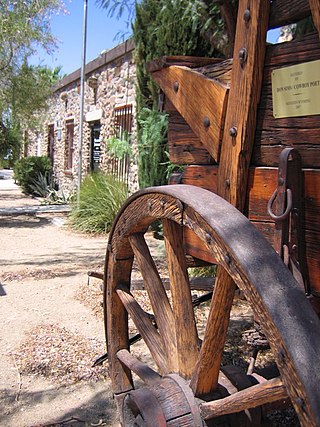
The Virgin Valley Heritage Museum, originally known as the Desert Valley Museum, is in Mesquite, Nevada and is listed on the United States National Register of Historic Places. The museum displays exhibits about area pioneers and local history.

Pueblo Grande Ruin and Irrigation Sites are pre-Columbian archaeological sites and ruins, located in Phoenix, Arizona. They include a prehistoric platform mound and irrigation canals. The City of Phoenix manages these resources as the S’edav Va’aki Museum.

Boulder City Historic District, is Nevada's largest listing on the National Register of Historic Places with 514 buildings. Among the buildings, 408 constructions were built during the first 11 years. Between World War II and 1950, 66 buildings were built; the rest 40 were constructed after 1950.
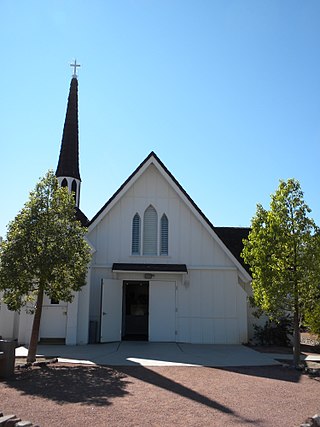
Clark County Museum is located in Henderson, Nevada and is owned and operated by Clark County. The museum includes the Anna Roberts Parks Exhibit Hall and Heritage Street which contains eight historic buildings from the county.
Mark Raymond Harrington was curator of archaeology at the Southwest Museum from 1928 to 1964 and discoverer of ancient Pueblo structures near Overton, Nevada and Little Lake, California.
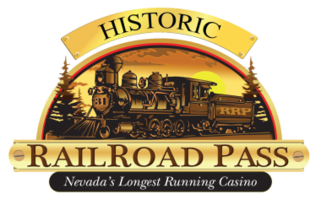
Railroad Pass Hotel & Casino, named after nearby Railroad Pass, is a hotel and casino located in Henderson, Nevada.

Callville Bay is a waterway on the northwestern side of Lake Mead in the U.S. state of Nevada. It has a marina and camping resort. Situated east of Las Vegas and upstream from Las Vegas Bay, it lies within the Lake Mead National Recreation Area, which was established in 1935. Its name derives from the settlement of Callville which was established in 1865 by Anson Call under a directive led by Brigham Young. Though the settlement was abandoned in 1869, and submerged under Lake Mead when the Colorado River was dammed, Callville Bay retained the name.

Callville is a former settlement of Clark County in the U.S. state of Nevada. Abandoned in 1869, it was submerged under Lake Mead when the Colorado River was dammed, Callville Bay retaining the name. At one time, it was noted to be the southernmost outpost of the Mormon settlement.
Boulder Canyon, originally Devils Gate Canyon, is a canyon on the Colorado River, above Hoover Dam, now flooded by Lake Mead. It lies between Clark County, Nevada and Mohave County, Arizona. It heads at western end of the Virgin River Basin of Lake Mead, at about 36°09′05″N114°32′51″W. Boulder Canyon divides the Black Mountains into the Black Mountains of Arizona, and the Black Mountains of Nevada. Its mouth is now under the eastern end of the Boulder Basin of Lake Mead, between Canyon Point in Nevada and Canyon Ridge in Arizona. Its original mouth is now underneath Lake Mead between Beacon Rock and Fortification Ridge on the southern shore in Arizona.





















